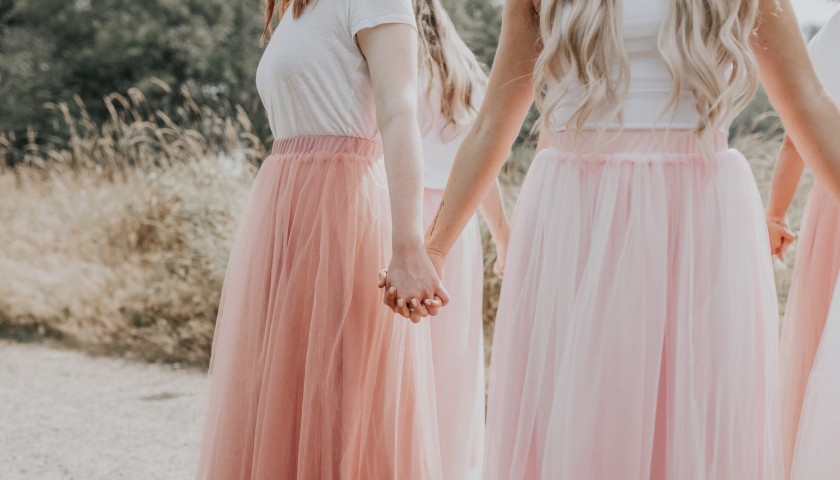by Cadence McManimon
It doesn’t take a fashion designer’s sense to notice the decline of American clothing in the last few decades. The neat suits and dresses of yesteryear have been replaced with stretchy athleisure, the hats and coats vanished in favor of sweatshirts and leggings.
Quite honestly, I don’t think fashion and clothing is all that important. Sure, we’ve lost some aesthetics and have nearly erased any sense of modesty. But in the end, clothes are still just clothes, right?
And yet, even the humblest elements of history have something to teach us in this regard.
For example, I have been a skinny jeans girl all my life. I literally used to sleep in jeans as a teenager! I prioritize comfort, as do most of my generation. I would be the last person anyone would expect to promote a return to wearing dresses. And yet, here I am, writing this while wearing an ankle-length skirt. What happened to me, a lover of comfortable modern clothes?
I got pregnant. How very ordinary, right? I am currently expecting my third child with my husband, and since during my pregnancies I tend to get extremely sick, clothing choices rank at the absolute bottom of the priority list. That is, until this third time around, when I have some new symptoms. Let’s just say I am dealing with some inflammation in very sensitive areas! Tight clothes, legging seams, and denim fabric only worsen the discomfort. So, I’ve had to put away my beloved jeans in favor of soft skirts and dresses.
And that’s when I realized why skirts have been so very practical throughout most of history. Most women, up until recent decades, did a lot more childbearing in their lives. It was common to have at least three children, if not seven or eight or more. Of course skirts would be more comfortable than pants as women carried, delivered, and nursed many consecutive babies! It’s only in recent decades that birth rates and motherhood have drastically decreased.
On top of that, skirts and dresses are also far more adjustable for changing figures and weight fluctuations, which are a natural part of childbearing. I’ve been surprised these days that the garments that fit me the longest through my pregnancies are different dresses I’ve had since I was a teenager. Historically speaking, this type of adjustability was imperative during centuries when women could only afford two or three dresses. They needed clothes that would fit many seasons of life—it was simply impossible to buy different clothes for different body changes, as we have the option to do today.
Along with that, historical—that is, non-synthetic—fabrics are far more durable. In the last couple of decades, we have had the luxury of clothing made of elastic fabrics. Clothes made of nylon blends, spandex, and jersey can stretch and accommodate pregnancies easily, as well as being affordable. So why am I nevertheless turning to skirts these days? Simple. Those elastic fabrics don’t hold up. They function like a rubber band and can only be stretched so often before losing their ability to “snap back.”
The stretchy clothes I do have remain functional for only a year or so. The longest-lasting fabrics—coincidentally, those my dresses are made of, are woven from natural fibers such as cotton, linen, and wool. These fibers are simply more durable, and because they don’t stretch, they last for years and don’t wear out with laundering. It’s easy to see how this greatly benefited mothers throughout history.
Along with these unexpected practicalities, I’ve also come face to face with dresses being gendered clothing. Our culture has distinctly pursued androgyny and unisex fashion, where men can wear women’s clothing or vice versa. Wearing traditional clothing is not in itself going to fix the gender confusion in our culture. But it does make an often subliminal visual statement.
I recently came across this post by the Modest Mom from way back in 2012. I was impressed that her primary reasoning for dressing traditionally was not Biblical modesty, as I expected of her, stereotypically. Instead, she wrote about the stark visual difference skirts give to denote the female versus the male form. She said this is a very easy way to show her children the beauty and differences between the sexes.
It reminded me of an experiment I took part in back in college. I, my sister, and a good friend were all in the depths of our coursework, and we had a lot of male classmates. We were discussing one day the popularity of androgynous athleisure fashion on our respective campuses. One of us had the bright idea to try a little social experiment just to see what would happen if we dressed completely femininely. So, on a normal day of classes, we each wore a pink dress all day long—and, yes, we agreed it had to be pink.
We were shocked at the results. Yes, female students would comment “I like that outfit!” or “You look cute.” But the more drastic change came from our male classmates.
My friend was in organic chemistry with almost exclusively male students; in her group project, she’d been pulling most of the weight in writing a hefty paper. But during the pink dress day, every member of her group offered to do double the amount he’d previously contributed! My sister experienced chivalry in the streets—every car driven by a man stopped to let her cross the road that day. I was offered multiple better seats in lecture halls, and every single time, men I barely even knew opened the door to let me pass. Without exception, we saw a huge increase in the amount of positive attention and deference from men in every setting.
What was the lesson we learned? Men respond positively to women who look like women! Far from being preyed upon, as modern culture claims, looking feminine offered us three college girls more respect and kindness than wearing androgynous clothes ever did. And of course, I’m not the only writer to have noticed the difference dressing well can make in our lives.
“What does our own sloppy dress tell us about ourselves?” asks Jeff Minick. “Are we rebelling against the idea of beauty and culture? Or are we just too lazy to pull on a pair of slacks instead of wearing the sweats we slept in?”
As Maida Korte previously wrote on Intellectual Takeout, “Getting dressed in something more than flannel-patterned pants and a somewhat stale T-shirt signals that we are part of life and living it on purpose.”
In our modern culture, have we too quickly thrown out skirts? What have we lost by rejecting the classic gendered dress of yesteryear? I don’t think we need to burn our jeans or swear off leggings forever, but we could certainly consider the benefits of returning to clothing that reflects our traditional values. What might dressing traditionally look like in our modern culture? It can start very simply:
- Recognize the value and visual signals of a classically gendered appearance.
- Apply good hygiene in our daily habits.
- Take five minutes to do something extra for our appearance, like curling or braiding our hair or having a fresh shave.
- Choose our clothing pieces thoughtfully.
- Practice frugality by maintaining the clothing we already have.
There are so many small things like this we can practice, things that were commonplace mere decades ago. We don’t need to burn our newer wardrobes, or try to look like sock hop attendees, or start completely from scratch. A few small changes like this go a long way toward making our outward appearance reflect our values. Let’s rediscover the wisdom traditional culture can offer our modern closets.
– – –
Cadence McManimon is a published author, former special education teacher, and now a wife and mother. She has too many houseplants, plenty of artsy projects, and not enough pens that work! (Doesn’t everyone?) Her novels Name Unspoken and The Lily Girl are available at her website cadencemcmanimon.com. Her favorite things include crayons, sarcasm, Sherlock Holmes, and hearing from readers!








